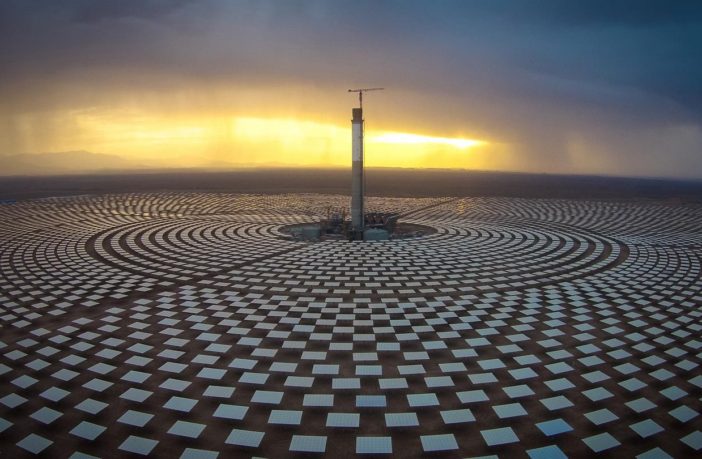DLR
In Morocco, the international tendering process for the Noor Midelt I solar power plant complex has been concluded. The contract was awarded to a consortium led by the EDF Group (France). Noor Midelt’s power generation capacity will exceed even that of its predecessor, Noor Ouarzazate, which is currently the largest solar complex in the world.
Both of these major projects combine concentrating solar power (CSP) with more economical electricity from photovoltaic (PV) generators. The benefit of this hybrid strategy is that average power generation costs are lower, while the CSP thermal storage systems enable solar-derived power to be supplied even during the evenings and at night. In the now-completed tender, a predicted price of 0.68 Moroccan dirhams per kilowatt hour of electricity was achieved, which equates to six eurocents at the current exchange rate. Controllable solar power has never been so inexpensive.
In North Africa, Morocco is a pioneer in the use of renewable energy sources such as wind and solar power, as well as hydroelectricity. The country plans to increase its share of sustainable power generation capacity to 42 percent by 2020, and 52 percent by 2030. The solar complexes in both Ouarzazate and Midelt are flagship projects under the Moroccan Noor Solar Energy Plan. Noor is the Arabic word for ‘light’. The Noor Ouarzazate project, which was completed in late 2018, obtains its total output of 580 megawatts from three CSP plants and one PV plant. Noor Midelt I will achieve a total output of 800 megawatts with two hybrid CSP/PV plants. Construction work is scheduled to begin in the autumn of 2019.
In the interview below, Robert Pitz-Paal, Director of the German Aerospace Center (Deutsches Zentrum für Luft- und Raumfahrt; DLR) Institute of Solar Research, assesses this event and its significance for research into the energy system of the future:
What does this mean for the ongoing development and deployment of solar thermal power plants?
The price of six eurocents per kilowatt hour is sensational, as it means that controllable solar power can, for the first time, compete with electricity generated by gas-fired power plants. The combination of CSP and PV can deliver electricity after sunset much more cost effectively than a PV plant with battery storage. This will make it possible for sunny countries to completely dispense with the importation of fossil fuels for power generation. At the same time, the construction of such solar power plants adds economic value within the country. The price is no higher than with previous systems. In my view, this offers many countries the opportunity to make a breakthrough in climate protection, while also contributing towards the development of their economies.
What are the main reasons for the low price?
It is a combination of two things. Firstly, it is up to 20 times cheaper to store heat in salt tanks than it is to store electricity in batteries. In addition, the price of PV solar power in sunny locations has dropped to less than three eurocents per kilowatt hour. The solar thermal power plant can be operated using stored heat when the sun is not shining. There are also a few tricks that these facilities use to further increase their efficiency. For instance, the system uses some of the PV electricity to further increase the temperature in the thermal storage system. The higher the temperature, the more electricity can be generated using the stored heat. At increased temperatures, more energy can also be stored within each kilogram of salt.
Which developments will further reduce prices in the future?
Numerous research initiatives are investigating how to reduce the costs of both photovoltaic modules and solar thermal power plants. In the case of PV modules, the combination of different layers within the solar cells is being pursued. The aim is to make better use of the various wavelengths in the incident radiation and thus get more power from every square metre of solar panel. A higher operating temperature also makes it possible to implement more compact thermal storage facilities and generate proportionately more electricity from the stored heat. I believe that the cost of ‘round-the-clock electricity’ will fall significantly below five eurocents per kilowatt hour in the medium term.
Will German companies be involved in the construction of the Noor Midelt power plant complex?
One of the partners in the EDF consortium is the TSK Group, with which DLR has developed a new parabolic trough collector; this is expected to be used for this project. The overall supply arrangements have not yet been determined but German companies are well positioned here. Siemens, for example, has so far supplied 80 percent of the steam turbines used in solar thermal power plants worldwide.
Will North Africa soon be supplying power to Europe?
This is not foreseeable in the short term. In addition to the power lines that would be required, the conditions for securing the necessary investment are also not currently satisfiable. A number of bilateral initiatives, such as the one between Tunisia and Italy, are under way; these could prove to be a breakthrough if they come to fruition.








